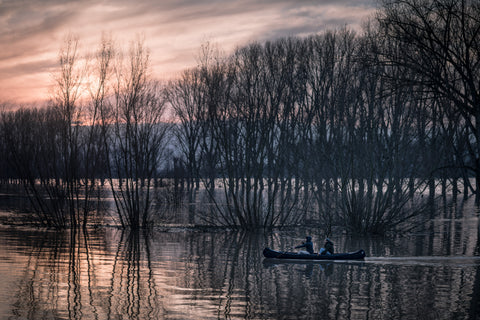Positive Eco News
Written by Mollie Knight
If you don’t follow us on Instagram (firstly, you’re seriously missing out), then you might not know that we like to post about positive news stories now and then to show that the world isn’t all bad - though I don’t blame you if in recent years you have developed a pessimistic streak. In honour of this year’s World Environment Day (5th June) and World Ocean Day (8th June), I thought I’d follow suit and put together some of the positive things that have happened in the past year – with an environmental theme of course!
1. Love Island’s New Sponsor

Source: MIC Gadget
Love Island returns to grace our screens with tan lines, tiny bikinis and tantalising drama – but this year something is different. Instead of the usual hyper-promotion of fast fashion brands like Missguided and Boohoo, Love Island has partnered with eBay to dress the contestants in second-hand clothes instead. This is a major step, especially considering the show’s entwined past with fast-fashion - remember the £1 bikini?. Famously, Molly Mae Hague also secured a Pretty Little Thing deal after the show and now is their creative director (). It will be interesting to see if eBay strikes a similar deal with this year’s contestants. Although we will have to wait to see the long-term effects of this partnership, I feel hopeful that it will make choosing second-hand pieces over fast-fashion a lot more popular.
2. COP26 Commitments

Source: World Meteorological Organisation
In October and November last year, the UN Climate Change Conference took place in Glasgow – also referred to as COP26. Though some of the commitments fell short, like failing to secure net-zero emissions by 2030, it did see some of the most ambitious commitments yet, that bring come closer to halting the climate breakdown (if of course the government actually puts their money where their mouth is).
3. New Marine Protected Areas

Source: Cuba Gallery
Some countries really stepped up to put protections in place for our marine life. Australia declared two new Indian Ocean reserves that combined cover 286,000 square miles of ocean, whilst Panama put in a marine reserve the same size as it’s land mass and Ecuador planned an expansion of the Galápagos Marine Reserve by 23,200 square miles.
4. The Private Sector Goes Green

Source: Californian Lutheran University
Yes governmental changes are super important in fighting climate collapse, but companies, individuals and foundations also have their own role to play. In September we saw the most money ever pledged toward conservation from private sources. The ‘Project Our Planet Challenge’ plans to protect 30% of the planet’s land and oceans by 2030 by using the $5 billion donated by nine different organisations.
5. Extinct No More

Source: Kevin Dooley
Since last World Environment Day, many species have managed to fight their way back from the brink of extinction (or even from extinction itself – being spotted in the wild again for the first time). Here in the UK, Kites managed to make their way back up to 2,000 breeding pairs having previously been as low as 37 in the 90s. The Giant Panda, native to China, moved from an endangered to a vulnerable status as a result of conservation efforts. There are now around 1,800 of the iconic bamboo-munching animal in the wild – maybe WWF will have to change their logo soon! The Bandicoot is also now thought to have a population of 1,500 up from 150. Despite massive amounts of plastic pollution and water acidification in our oceans and seas, two species have managed to make it through. Humpback whale numbers have risen to 93% of their original population before mass-whaling during the 1800s. Vaquitas are also facing a hopeful future despite only 10 individuals still existing in Mexico. A study has shown that the species is healthy and has the potential to survive, as long as illegal fishing is controlled. In January, colonies of the tiny Tequila Splitfin have been discovered, after disappearing from the wild in 2003 due to human activity.
6. Reforesting

Source: Aleksandr Fokeev
An area of forest larger than the size of Madagascar or France (146 million acres) has completely regrown according to BirdLife International, WCS and WWF. Jane Goodall also pledged to advise on the planting of 1 trillion trees by 2030 by Trees for Jane, Trillion Tree Campaign and Plant-for-the-Planet. She will be ensuring that the trees are being planted in a way that doesn’t negatively impact the ecosystems already there. These projects have the potential to seriously help with reducing the amount of carbon in the atmosphere.
7. Crack Down On Coal

Source: Dom Walton
This past year has seen a big move away from coal power (though not necessarily always in favour of more renewable sources). President Xi Jinping announced in September that China would not finance any more coal-fired power plants abroad. Also a report found that since the Paris Agreement was signed in 2015, plans for 75% of coal plants were put on pause or cancelled – definitely a move in the right direction!
8. European Cities Step Up

Source: Zatato
Many cities throughout Europe have come up with unique ways to benefit the environment in urban and industrial areas. Zurich, catalysed by the war in Ukraine, is in the process of shutting down its natural gas network in whole sections of the city and encouraging alternatives in households, whilst Sweden built a wooden skyscraper that can sequester as much as nine million kilograms of CO2 throughout its lifetime – the equivalent of 10,000 forests. Tallin has implemented so many great projects to improve the wellbeing of wildlife and their residents, including making almost 20% of the city’s land mass green space – not just for the residents but for the pollinators and insects too.
9. Innovative Inventions

Source: EU Civil Protection and Humanitarian Aid
At COP26 the star of the show was new atmospheric methane removal technology which would break methane down into smaller particles of CO2, which traps less heat than methane. At a Swedish university in 2017, researchers found a way to capture and store solar energy for up to 18 years. Now they have been able to successfully produce electricity from this system, which could revolutionise solar power. In February, students from Coventry Business School designed a ‘floating house’ to save people from floods and rising sea levels, inspired by seasonal floods and natural disasters that happen in Vietnam.
10. Recognition of Indigenous Peoples' Role

Source: Rafael Wagner
While fights for land continue, throughout this past year the role that Indigenous peoples play in combating climate change was recognised, including at COP26. During the second week of the conference, a study was released during the that outlined evidence showing that if tropical rainforest nations want to meet their Paris Agreement goals, the most effective action they can take is to give land rights back to indigenous groups. In September, the IUCN World Conservation Congress voted in favour of protecting 80% of the entire Amazon Basin by 2025, an Indigenous-lead measure. 61 governments approved and 600 NGOs and Indigenous representatives also voted in favour.
Concluding Thoughts
Some of these news stories are very positive and give hope that good change is happening around us, though it can sometimes be over-shadowed by the bad. It is important to celebrate our achievements as well as our short-comings. The even better news is that this list doesn’t include everything that has happened, there is so much that has changed in 2022 alone! Let us know what your favourite good news story of the past year was in the comments or over on our Instagram and make sure to share these stories with anyone you know who might need a little boost!
